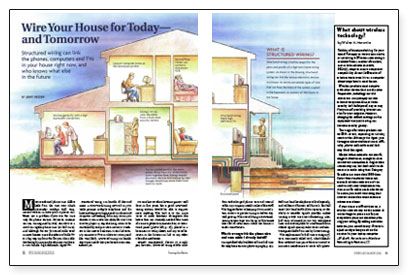Wiring Your House for Today and Tomorrow
Structured wiring can link the phones, computers and TVs in your house right now, and who knows what else in the future.

Synopsis: Suggestions for where and how to install special cabling, called structured wiring, that is designed for high-speed Internet connections, and better telephone and audio/video signals. Newer wiring is far more versatile than standard telephone and coaxial cables.
Most residential phone wire differs little from the wire over which Alexander Graham Bell summoned Watson in history’s first phone call. That’s not a problem if you use the wire only for phone service. However, Internet service, unimagined by Bell, can slow to a crawl on regular phone wire (or bell wire). And although the RG 59 coaxial cable used in most houses since the advent of cable TV is a big step up from the flat 300-ohm cable that brought Lucy and Ricky into our lives, it can’t handle high-definition digital TV.
Structured wiring can handle all this and more. A structured-wiring network in your walls permits multiple telephone and fax lines and supports high-speed modems and computer networking from any room you choose. It can create the ability for one VCR or DVD player in, say, the living room to be controlled by and provide a movie to watchers in the master bedroom. It can link security cameras to TVs in whatever room you’d like. Very likely, structured wiring can handle electronic needs that you haven’t even considered yet.
No one knows what electronic gizmos we’ll have in five years, but a good structured wiring system should be able to support most anything. The trick is to run more wires to more locations throughout the house than are currently needed. The wires all come together at a junction box, or structured panel, placed in a basement or utility closet, and any wired location in the house can link to any other when the need arises.
Sounds complicated, doesn’t it? Simply put, however, structured wiring is little more than turbo-charged phone wire and coaxial cable. My company installs miles of the stuff. The biggest factor to keeping down installation costs is to get the wiring in before drywall goes up. The cost of doing a structured wiring system later can be up to four times the cost of installation while the home is under construction.
What’s wrong with the phone wire and coax cable I already installed?
I’m mystified why builders still use bell wire for telephone service. Bell wire handles telephone calls adequately, and millions of homes still have it. But bell wire’s low bandwidth (data capacity, or the ability to transfer signals quickly) makes viewing a Web site over it frustrating. Also, bell wire is limited to just two telephone lines and is susceptible to interference from outside signals (mostly radio waves and electromagnetic fields from nearby house wiring).
The replacement for bell wire is category 5 wire, commonly called cat 5, which blends four insulated wire pairs that are twisted to minimize interference or cross talk. Each pair is capable of a separate function, such as a phone, fax or computer-network link. We don’t install regular cat 5 anymore, preferring the broader bandwidth available with cat 5e (e for enhanced) cable. Cat 5e costs only about $9 more per 1000 ft. than does cat 5, and it dramatically increases bandwidth. Cat 5 and cat 5e each cost more than twice what bell wire does. Although that sounds like a lot, the difference amounts to maybe $50 for a house.
For more illustrations, photos, and details, click the View PDF button below:
Fine Homebuilding Recommended Products
Fine Homebuilding receives a commission for items purchased through links on this site, including Amazon Associates and other affiliate advertising programs.

100-ft. Tape Measure

Plate Level

Smart String Line


























